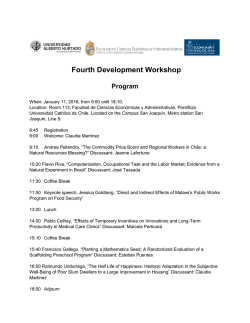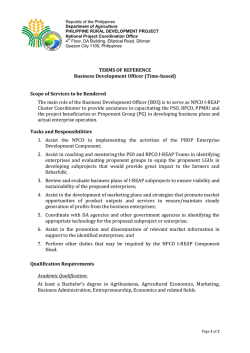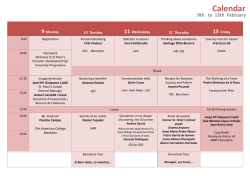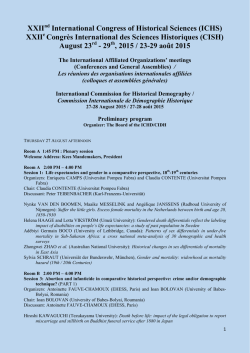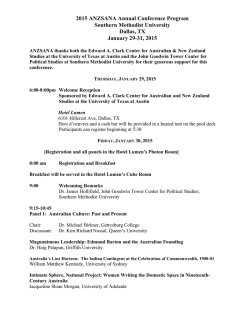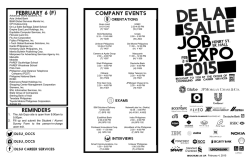
2015 BSP-UP Professorial Chair Lectures
2015 BSP-UP Professorial Chair Lectures 19 – 20 October 2015 Executive Business Center 5-Storey Building, BSP Complex, Manila TENTATIVE PROGRAM Day 1 - 19 October 2015 (MONDAY) 09:00 - 09:30 Registration 09:30 - 09:40 Philippine National Anthem 09:40 - 10:00 Welcome Address Governor Amando M. Tetangco, Jr. Bangko Sentral ng Pilipinas 10:00 - 10:20 Opening Remarks President Alfredo E. Pascual University of the Philippines System 10:20 - 10:30 Photograph taking 10:30 - 10:45 Coffee / Tea Break 10:45 - 10:50 Introduction of Lecturer and Discussant 10:50 – 11:30 Lecture 1: Corporate Income Taxes and Utility Rates in the Philippines Lecturer: Dr. Helena Agnes S. Valderrama BSP-UP Centennial Professorial Chair in Accounting Abstract: This paper elucidates and endeavors to put a framework to the arguments on the appropriate treatment of income taxes in regulated rates in the Philippines. It identifies changes in regulatory conditions since the 2002 Supreme Court decision and differences between electricity and water rates determination that should inform current thinking on this issue. Finally, the paper presents analysis on the performance of Meralco pre and post the 2002 Supreme Court decision to attempt to determine what have been the financial effects on the company of the inability to pass on its CIT in electricity rates. 11:30 - 11:45 Discussant: Dr. Felipe M. Medalla Monetary Board Member Bangko Sentral ng Pilipinas 11:45 - 12:00 Open Forum 12:00 - 13:30 Professor Ernesto M. Pernia Professor Emeritus of Economics School of Economics University of the Philippines 13:30 - 13:35 Introduction of Lecturers and Discussants 13:35 - 14:15 Lecture 2: Corporate Investments in Asian Markets: Financial Conditions, Financial Development, and Financial Constraints Lecturer: Dr. Maria Socorro Gochoco-Bautista BSP Sterling Professorial Chair in Monetary and Banking Economics Abstract: We examine the mechanisms through which finance affects corporate investments and capital accumulation in 5 Asian countries using firm-level data. In particular, we examine whether financial conditions and a country's level of financial development each play role in relieving a firms' external financing constraints. When present, the latter manifests itself in the form of a firm's sensitivity to its cash flow. We find that a country's level of financial development affects firm external financing constraints. Small firms, in particular, benefit from financial development. The effects are asymmetric in that they are stronger during crisis periods than in subsequent rebound periods. 14:15 - 14:30 Discussant 2: TBD 14:30 - 15:10 Lecture 3: The Leader as Friend: Implications of Leonardo Polo’s Friendship in Aristotle for Humanistic Corporate Governance Lecturer: Dr. Aliza D. Racelis BSP-UP Centennial Professorial Chair in Business Administration Abstract: This paper endeavors to show that Polo’s essay on Aristotle’s notions of friendship in his Amistad en Aristóteles has important implications for humanistic corporate governance, in particular through Page 2 of 8 Polo’s discernment of the nature and virtues of friendship as they may relate to leadership. Concretely, one can draw those virtues that are natural to him as a human being and as an authentic friend, which at the same time accompany his transcendental leadership of self-gift and service to others. Firstly, there are the chief moral virtues ―or the cardinal virtues― of: (1) prudence, (2) justice, (3) fortitude, (4) temperance. In addition, there are the virtues of: (5) humility, (6) veracity, and (7) love, or charity. It is hoped that, by highlighting these characteristics of a true friend contained in Amistad en Aristóteles ―especially the superiority of Christian charity over the natural friendship notions of Aristotle―, we have provided clear indications for how the authentic friend-leader turns out to be the ideal moral leader who will bring about that much-desired human flourishing in organizational members and, by extension, successful business outcomes. The assertion here is that “transcendental leadership”, i.e., leadership by way of transcendent motives (in addition to extrinsic and intrinsic motives), whereby the leader makes himself have a genuine interest in the development of and in contributing to the good of the follower, has tremendous potential for a better organizational functioning. 15:10 - 15:25 Discussant: Dr. Oscar G. Bulaong, Jr. Professor Ateneo Graduate School of Business 15:25 - 15:50 Open Forum 15:50 – 16:05 Coffee / Tea Break 16:05 - 16:45 Lecture 4: Constructing Leading Economic Indicators for the Philippine Economy using Dynamic Factor Models Lecturer: Prof. Manuel Leonard F. Albis BSP-UP Centennial Professorial Chair in Statistics Abstract: The country’s small and open economy is vulnerable to both internal and external shocks. Is it therefore important for policy makers to have timely forecasts on the movement of the country’s Gross Domestic Product (GDP), whether it will increase or decrease in the current quarter, to be able to guide them in coming up with appropriate policies to mitigate say, the impact of a shock. The current method used to forecast the movements of the GDP is the composite Leading Economic Indicators System (LEIS) developed by the National Economic Development Authority (NEDA) and the Philippine Statistics Authority (PSA). The LEIS, using 11 economic indicators, provides one-quarter forecast of the movement of the GDP. This paper presents an alternative, and perhaps better, procedure to the LEIS in nowcasting the movements of the GDP using the Dynamic Factor Models (DFM). Page 3 of 8 The idea behind the DFM is the stylized fact that economic movements evolve in a cycle and are correlated with co-movements in a large number of economic series. The DFM is a commonly used data reduction procedure that assumes economic shocks driving economic activity arise from unobserved components or factors. The DFM aims to parsimoniously summarize information from a large number of economic series to a small number of unobserved factors. The DFM assumes that co-movements of economic series can be captured using these unobserved common factors. This paper used 30 monthly economic indicators in capturing a common factor to nowcast movements of GDP via the DFM. In addition to the DFM, the paper also constructed a two-stage dynamic factor models using Principal Components 16:45 - 17:00 Discussant: 17:00 - 17:15 Open Forum Ms. Ma. Christina S. Simbulan Bank Officer III, Inclusive Finance Advocacy Staff Bangko Sentral ng Pilipinas Master of Ceremonies: Micaela G. Alvarez Bank Officer V, BSP Page 4 of 8 Day 2 - 20 October (TUESDAY) 09:00 – 09:05 Introduction of Lecturers and Discussants 09:05 - 09:45 Lecture 5: Measuring Trade in Value-Added: Implications on Trade and Industrial Policies Lecturer: Dr. Ma. Joy V. Abrenica BSP-UP Centennial Professorial Chair in Foreign Trade Abstract: This paper uses the new WTO-OECD trade data capturing the flow of value added across economies to examine views on the nature of a country’s participation in the chain and the benefits derived therefrom. The empirical evidence suggests that incurring negative net value-added, engaging in shorter value chains, locating upstream (rather than downstream) in the chain, or producing in traditional (instead of hightechnology) industries, does not limit a country’s ability to create more value. A country’s benefit from GVC participation, however, is positively and significantly correlated to the degree of its backward participation – suggesting that accessing competitively priced imported inputs enables it to capture a larger share of the GVC value. The findings reinforce the view that the development imperative presented by GVC is vertical specialization, not vertical integration. Hence, it does not matter if a country has more forward or backward linkages, integrated in a long or short value chain, undertaking activities upstream or downstream in the chain, or engaged in high-tech or traditional industries. More important is the ability to harness for domestic growth the value created through its participation. Hence, concerns about dependency on imports and producing only a segment of production are misplaced and have no place in tightly interdependent global markets. 09:45 - 10:00 Discussant: Dr. Myrna S. Austria Vice Chancellor for Academic Affairs, School of Economics De La Salle University 10:00 – 10:15 Coffee / Tea Break 10:15 - 10:55 Lecture 6: Dissecting the Statistical Aspects in Credit Risk Assessment: Validation of Rating Systems and Probability of Default Estimation Procedures Lecturer: Dr. Jeffry J. Tejada BSP Sterling Professor of Government and Official Statistics Page 5 of 8 Abstract: The “internal ratings-based” (IRB) approach of Basel II allows banks to utilize their own internal methodologies in determining the different aspects of credit risk, including the computations of PD, LGD, and EAD. As a regulatory body, the Central Bank should be able to assess the soundness of such methodologies as well as develop procedures to efficiently validate rating systems used by banks. Many of the aspects surrounding credit risk determination and assessment have to do with statistical concepts and procedures. This lecture discusses some theoretical and practical ideas behind the statistical formulas proposed in the credit risk conversations in the Basel Accords. Specifically, validation of rating systems and PD computational approaches will be reviewed and explained at a practical level. Statistical measures such as the accuracy ratio and the receiver operating characteristic will be dissected in order to have an understanding and appreciation of such measures in assessing discriminatory power. A thorough understanding of validation methods is needed by bank supervisors/regulators in order to be able to review banks’ internal rating processes and to evaluate whether such processes comply with agreed standards. This lecture hopes to contribute to the attainment of this goal. 10:55 - 11:10 Discussant: Dr. Corinne Grace B. Burgos Adjunct Faculty Asian Institute of Management 11:10 - 11:50 Lecture 7: Philippine Fungal Diversity: Benefits and Threats to Food Security Lecturer: Dr. Christian Joseph R. Cumagun BSP-UP Centennial Professorial Chair in Agriculture Abstract: Fungal diversity plays a vital role in sustaining human life, either benefiting or threatening food security. Benefits derive from fungi range from food, medicine, to decomposition of organic matter, recycling of nutrients and plant growth promoter, including biological control of fungal plant pathogens. Fungal threats as pathogens of agricultural crops and mycotoxin producers may be generally less as compared with the benefits they provide to mankind. The paper briefly describes the beginnings and development of mycology as a science in the Philippines and presents the main repositories of fungal cultures in the Philippines. The four case studies generated from my research are highlighted, namely: biological control of plant pathogens; microbial gifts from the rainforests for agriculture; breeding for resistance against cereal blast and sheath blight pathogen including population genetic studies; and Fusarium diseases and mycotoxins. In view of habitat loss and climate change threatening fungi, Page 6 of 8 there is an urgent need to promote fungal conservation for a sustainable agriculture and healthy planet. 11:50 - 12:05 Discussant: Dr. Edwin R. Tadiosa Mycologist National Museum of the Philippines 12:05 – 12:35 Open Forum 12:35 - 13:30 Lunch 13:30 – 13:35 Introduction of Lecturers and Discussants 13:35 - 14:15 Lecture 8: Financial Inclusion Through Expanding Housing Finance Services: Insights and Options from the Behavioral Economics Literature Lecturer: Dr. Toby Melissa C. Monsod BSP-UP Centennial Professorial Chair in Money and Banking Abstract: Promoting inclusive financial systems is an important public policy objective [NSFI 2015]. Of particular strategic interest is housing finance services; housing is a ‘key barometer for social well-being’ and the availability of debt financing for housing is critical in housing affordability and in the efficient operation of a housing system [Hoek-Smit 2009]. What are the current frontiers of debt finance for housing and what insights can behavioral economics provide to extend those frontiers to underserved market segments? This paper takes stock of the ‘housing finance problem’ and surveys the behavioral economics literature for how the challenge of expanding access may be framed and addressed. 14:15- 14:30 Discussant: Ms. Pia Bernadette R. Tayag Director, Inclusive Finance Advocacy Staff Bangko Sentral ng Pilipinas 14:30 - 15:10 Lecture 9: Demographic Sweet Spot and Dividend in the Philippines: The Window of Opportunity is Closing Fast Lecturer: Dr. Dennis S. Mapa BSP Sterling Professorial Chair in Government and Official Statistics Abstract: Studies that investigated the impact of the demographic transition on economic growth have shown that demographic transition accounts for a sizeable portion (about one-third) of the economic growth experienced by East Asia’s economic “tigers” during the period 1965 to 1995. It is depressing to note that unlike most of its Southeast and East Page 7 of 8 Asian neighbors, the Philippines failed to achieve a similar demographic transition in the past decades. In all of these countries (including the Philippines), the mortality rates broadly declined at similar pace. However, fertility rates dropped slowly in the Philippines resulting in relatively high population growth rate for the country, compared to its neighbors in Asia. Thus, the demographic window of opportunity is closing fast for the country. This paper looks at the population structure of the country from 2010 to 2100, using actual census data from the Philippine Statistics Authority (PSA) and projections on future population from the United Nations (UN), to estimate the period when the country will experience the demographic window of opportunity. The paper will show that at current conditions (baseline scenario), there is a high probability that the country will entirely miss this rare opportunity of additional economic growth, over a long period of time, due to the demographic dividend. This is primarily so because of challenges related to the relatively high fertility rates, particularly among the poorest households, and the relatively high unemployment rate, particularly among the youth population. The paper will then provide counterfactual conditions, from the results of the econometric models, and simulate alternative scenarios resulting from fine-tuning certain policy handles. 15:10 - 15:25 Discussant: Dr. Alejandro N. Herrin Professor, School of Economics University of the Philippines 15:25 - 15:55 Open Forum 15:55 - 16:20 Closing Remarks Deputy Governor Diwa C. Guinigundo Monetary Stability Sector Bangko Sentral ng Pilipinas 16:20 - 17:00 Coffee / Tea Break Master of Ceremonies: Micaela G. Alvarez Bank Officer V, BSP Page 8 of 8
© Copyright 2025
